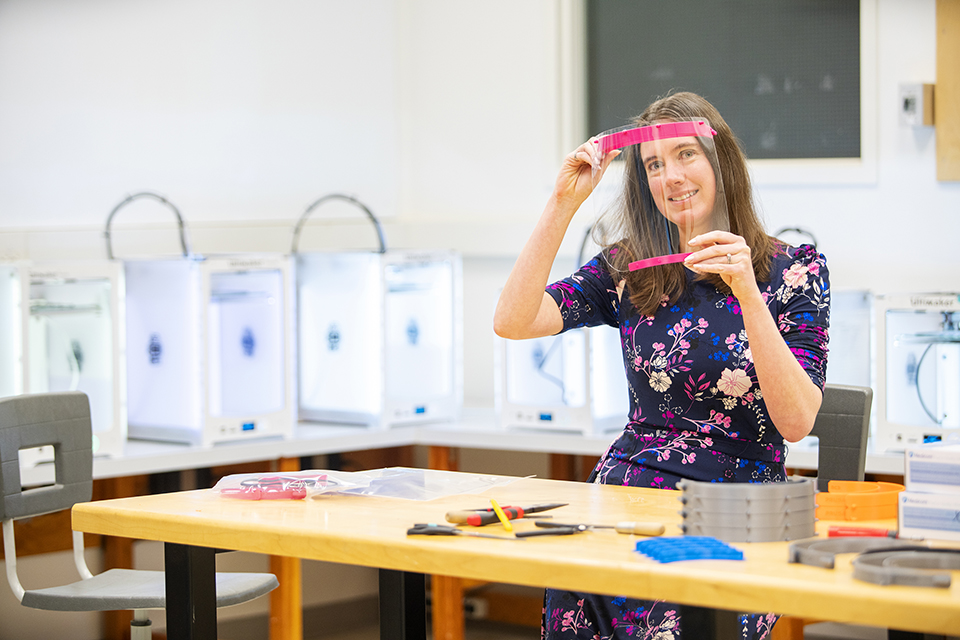In 2020, like many of her colleagues around the world, Stephanie Willerth, MS 2008, PhD 2008, looked to her own expertise for ways to help address the challenges of the COVID-19 epidemic. She came up with an innovative idea that protected frontline health care workers from exposure to the virus: 3D printed medical-grade face shields.
A biomedical engineer at the University of Victoria in British Columbia, Canada, Willerth mobilized students, community partners, university alumni, and others in an initiative to produce, sanitize, and distribute thousands of the face shields to medical staff in Victoria. A novel operation at the time, it quickly caught on in health care communities around the world that were desperately seeking protection from an unknown, highly contagious virus.

Willerth holds a Canada Research Chair in Biomedical Engineering and has dual appointments in the Department of Mechanical Engineering and the Division of Medical Sciences as a professor. Her interdisciplinary research group develops novel tools for use in primarily neural tissue engineering and regenerative medicine.
That same year, Willerth teamed with scientists Laura De la Vega and Laila Abelseth to launch a start-up to meet an increasing demand for innovative bioinks, substances made of natural and/or synthetic components that are compatible with living cells. Their company, Axolotl Biosciences, prints hiPSC-derived neural cells critical to the work of academic scientists and biotechnology companies that are advancing the field of tissue engineering and regenerative medicine.
About Axolotl Biosciences
Axolotl Biosciences is part of growing biotechnology ecosystem on Vancouver Island. A new facility, funded by the Government of British Columbia, will support six local companies annually with access to low-cost, high-demand and specialized lab space. “Having a dedicated biomanufacturing facility here on the Island will catalyze our growing biotechnology ecosystem while providing opportunities for our early-stage companies that are ready to translate prototypes into commercially relevant proof-of-concept products in an industrial setting,” said Willerth.
These achievements, coupled with the impactful teaching and research Willeth does every day as a professor and director of Victoria University’s Centre for Biomedical Research, have earned her distinguished recognition. Washington University honored Willerth with a 2020 McKelvey Emerging Leader Award, given to young engineering alumni who exemplify leadership and service through scientific excellence and innovation.
The University of Victoria also paid tribute to Willerth in 2018 with a REACH Award for Excellence in Research Partnerships with Aspect Biosystems. The award is presented to those individuals dedicated to the highest standards of teaching, research, and creative activity.
Described by her colleagues as a “star researcher who pushes boundaries,” Willerth was named Woman of Innovation—one of 20 leading women in Canada who have influenced engineering—in 2017. She is also the author of Engineering Neural Tissue from Stem Cells (Academic Press, 2017).
In addition to earning master’s and doctoral degrees in biomedical engineering from Washington University, Willerth also earned bachelor’s degrees in biology and chemical engineering from the Massachusetts Institute of Technology.
Related content
Bioprinting: 3D Printing Body Parts
Students learn how to replicate or treat a part of the human body using a 3D printer and bioink, a substance made of natural and/or synthetic components that are compatible with living cells.
In one recent class, 35 students worked on projects that included: ear parts designed to correct deformities, breast tissue that could act as a living implant following a mastectomy, a nose-shaped bandage to deliver medication to skin cancer, and a replacement for a deteriorating heart valve.